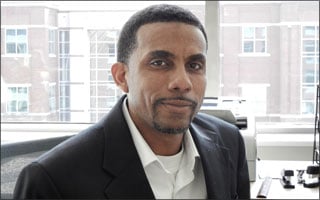Engineering new tissues with stem cells

Warren Grayson, assistant professor in Johns Hopkins Department of Biomedical Engineering, developed an interest in tissue engineering, oddly enough, on the soccer field. While studying chemical engineering at the University of the West Indies, the native of Trinidad was playing center midfield — until he tore his meniscus and had to visit an orthopedic surgeon.
While most of his peers in chemical engineering went to work for the oil and gas industry, Grayson’s interaction with his orthopedic surgeon piqued his interest in medicine. He wondered how he might combine his chemical engineering training with a career in medicine, and that took him to Florida State University for a PhD in biomedical engineering, followed by work as a postdoc at Columbia University.
“My PhD adviser was giving a seminar about stem cells from bone marrow tissue and how these respond differently in three-dimensional scaffold environments compared to traditional tissue culture flasks or Petri dishes,” says Grayson.
Now Grayson’s work centers on growing bone and skeletal muscle from adult stem cells pulled from bone marrow and fat tissue. Since cells in the body don’t grow on flat surfaces, these stem cells are placed on 3-D biomaterial scaffolds. “Once you take these cells and biomaterial and try to implant that into the body, the idea is that the cells regenerate new tissues that become integrated into the host tissue,” Grayson says. In other words, engineered bone grown inside or outside the body would integrate with bone tissue in, say, a knee or hip inside the body.
This research is so promising that Grayson recently received a National Science Foundation CAREER Award to support his work. Grayson will use the $400,000 in funding over five years to investigate how stem cells make decisions to become one specialized cell type or another in the developing tissue. NSF CAREER awards recognize a high level of promise and excellence in early-stage scholars.
As Grayson puts it: “It would provide fundamental understanding about the best methods to deliver cells within biomaterials to guide them to develop in predetermined ways. Do that, and figuring out how to engineer bone tissue that will survive in a human host once transplanted will follow,” he says.
— Andrew Zaleski
